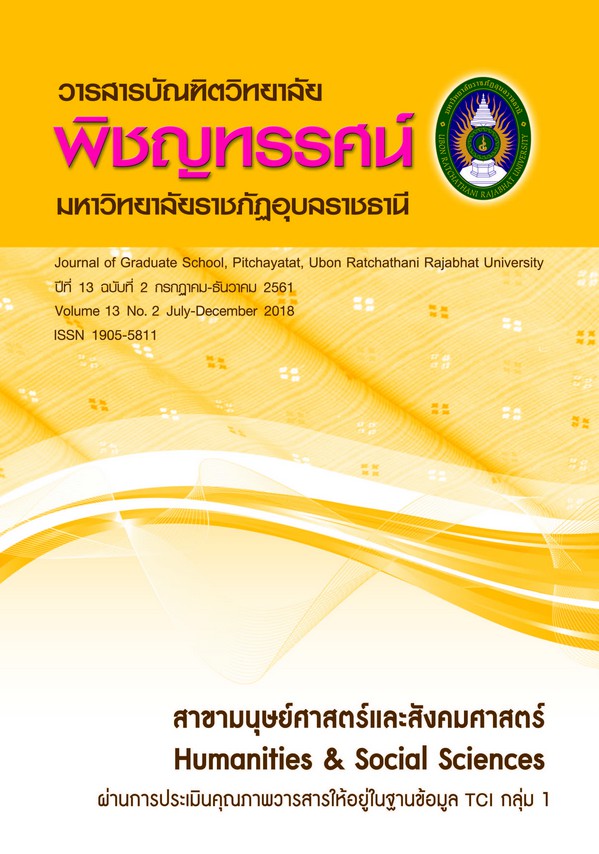Khse-muoy in the Kingdom of Cambodia
คำสำคัญ:
Khse-Muoy, Gourde Lute, Indigenous music, Teaching, Cambodiaบทคัดย่อ
The Khse-muoy is a traditional Cambodian chordophone instrument played by strumming and is capable of producing harmonic notes. Khse-muoy is a primary instrument in traditional Cambodian ensembles and provides music and entertainment for Cambodian traditions, celebrations, ceremonies and rituals. This qualitative study aimed at : 1) to study about the teaching process of Khse-muoy in Cambodia and 2) to study about the role of Khse-muoy in Cambodian traditions. The field data were obtained through interviews and observations with the Key informants which consisted professional Khse-muoy musicians and teachers. Casual informants, in Cambodia October 2014 to September 2015. The results of the study showed that Teaching Khse-muoy in the Kingdom of Cambodia are consistent and follow oral tradition and can be classified into 4 aspects of 1) teachers characteristics, 2) teaching location, 3) content and 4) teaching mediums. The primary instructors of Khse-muoy are the professional Khse-muoy musicians themselves but can also include senior students which aid in the lessons and practices by providing students with a model to follow on. The location of the lessons and teachings is different according to each teacher and it is usually the Khse-muoy musicians themselves who will decide on the location of the lessons. The content of the lessons on Khse-muoy are compiled directly by the Khse-muoy teachers and usually encompasses music and songs that accompany tradition activities. The learning materials of Khse-muoy may differ from teacher to teacher but the essential medium is the Khse-muoy instrument itself and not all classes and lessons are performed by following music notes. The majority of lessons are usually oral lessons and demonstrations by the teacher and senior students. And current the role of khse-muoy in the Cambodian tradition in the three most popular traditions for Khse-muoy are phiti rieb-ka (wedding ceremony), phiti kat so (cork shaving ceremony) and phiti-ara (healing ritual).
เอกสารอ้างอิง
Clamor, Ana Maria. Non-Partisanship A Curriculum for NGOs Pact Cambodia. Phnom Penh: Cambodia, 2001.
Ines, Sothea. Dontrey : the music of Cambodia : Sākalvidyālăy Bhūmin Bhnaṃ Beñ. Phnom Penh, Cambodia : Royal University of Phnom Penh, Department of Media and Communication, 2011.
Kaew, Narom. Khmer Music. Siem Reap, Cambodia: Angkor Wat Publishing, 2011.
Kim, Sara Junghwa. An exploratory study to incorporate Supplementary computer assistant historical and theoretical studies into applied music instruction (perform). Dissertation Abstract International. 57, 2 (August 1996): 507-A.
Mckinley, Kathy. Ritual, Performativity and Music Cambodian Wedding Music in Phnom Phen. Rhode Island: Brown University, 2002.
Ngoc, Huynh Thi. Cham Sculpture and Indian Mythology. Danang, Vietnam: Danang Publishing House, 2002.
Raman, Chandrasekhara Venkata. On Some Indian Stringed Instruments. Proc. Indian Assoc Cultive. Sci. 7,29-33 (1921): 468-472.
Ratchakrit, Kongpinitbovorn. The Pleng Kar of the Khmer people: A case study of the oddarmeanchey troupe-osamed sub-district, Samrong district in oddameanchey province Cambodia. Bangkok: Office of the University Library, Kasetsart University, 2010.
Silva, R. C. L. From School to “Real World” Jazz: Learning Improvisation in a Community of practice. Relevance and Reform in the Education of Professional Musicians, 2014.
Sumate, Kongsawat. Beliefs of the Villagers of Ban Phluang, Tamban Kang-Aen, Amphoe Prasat Surin. Mahasarakham: Academic Resource Center, Mahasarakham University, 1986.
Terry Miller, Sean Williams. The Garland handbook of southeast asian music. New York: Routledge Taylor & Francis Group, 2008.
Wimala, Siripong. Kan Suepthot Watthanatham Dontri Thai Nai Sangkhom Thai Patchuban Sueksa Korani Sakun Phat Yako Son Lae Sakun Sinlapa Banleng. Bangkok: Thammasat University Library, Thammasat University, 1991.
ดาวน์โหลด
เผยแพร่แล้ว
รูปแบบการอ้างอิง
ฉบับ
ประเภทบทความ
สัญญาอนุญาต
บทความทุกเรื่องได้รับการตรวจความถูกต้องทางวิชาการโดยผู้ทรงคุณวุฒิภายนอกอย่างน้อย 3 คน ความคิดเห็นในวารสารพิชญทรรศน์เป็นความคิดเห็นของผู้นิพนธ์มิใช่ความคิดเห็นของผู้จัดทำ จึงมิใช่ความรับผิดชอบของวารสารพิชญทรรศน์ และบทความในวารสารพิชญทรรศน์สงวนสิทธิ์ตามกฎหมายไทย การจะนำไปเผยแพร่ต้องได้รับอนุญาตเป็นลายลักษณ์อักษรจากกองบรรณาธิการ





